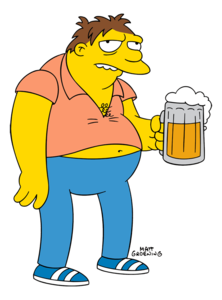
Of these negative portrayals of alcohol, Sljukic says, “The single most troubling one is drunk driving. The episode “Duffless” (Season 4, Episode 16) is a culmination of many of these factors, and depicts blatant sexist advertising, the beer industry’s neglect for health consequences, and ends with Homer getting a DUI. Frequently, characters drink too much and go one step further by operating vehicles under the influence. In “The Springfield Files” (Season 8, Episode 10), Homer overindulges and walks home after failing a breathalyzer test, leading to the opening of a larger tale. As he notes, the centrality of bar culture to “The Simpsons” is no accident: Sam Simon, a producer of the show, was also a writer and producer on the first three seasons of “Cheers.” “The episode, ‘Flaming Moe’s,’ is pretty much an homage to ‘Cheers,’” he says, stressing the importance of the bar as a narrative device.įor all the moments in the show that allude to barside camaraderie, the centrality of the bar as a social space often plays out in negative ways. Mark Sljukic, a former beer account manager and industry professional, is also a longtime “Simpsons” fan-the kind who would marathon seasons with his college roommate, analyzing episodes with an eye to his own dream of comedic writing. The kind that share more than a passing resemblance to Moe’s. I think of dives as a reliable constant in my life-the same way I can rely on laughing aloud when rewatching an old episode of “The Simpsons.” I find comfort in those bars that have been a little overlooked, are a bit rough around the edges-the kind that only take cash. In my head, those places were dank and dark growing up, but I’ve grown to love a good dive bar.” Everyone has those bars in their towns for the most part. “It doesn’t show drinking in a favorable light, and when I look at Moe’s, it is where this vice can be achieved. “Drinking is a really terrible vice that a lot of characters have,” Sauter says. “Bar culture in the ’90s a very male-oriented space, with macro brands, not having to be nice, and a ‘this is where I hide from my family’ attitude.” A character like Duffman-the exaggerated corporate mascot for the show’s Duff Beer brand, who contemporary viewers might note embodies a form of toxic masculinity-is of a time when, Sauter remembers, “Commercials from the Super Bowl a man picking a beer over his girlfriend.”Īside from the lack of diversity in the space, alcohol abuse at Moe’s is a recurring theme. On occasion, the space is inhabited by an array of guests, but the customer base rarely changes from the regular cast of barflys. It’s used as a recurring setting and plot device throughout episodes. Members of the Springfield community, mostly men, frequent Moe’s. It is a respite for certain people, for good or for bad.” As an Advanced Cicerone, Sauter jokes that she knows now that Moe Szyslak, the salty bartender and owner of Moe’s Tavern, definitely doesn’t clean his draft lines.

“They reminded me of what I would think of if I think of Moe’s. “Beer wasn’t part of my childhood at all, but there were two bars in my hometown growing up that were essentially like Moe’s,” says Sauter. Her wedding cake, too, was a “Simpsons” reference. Em Sauter of Pints and Panels, a comic about beer education, was so fond of the Gracie Films jingle that the pianist at her wedding played it to conclude the reception.
#Barney gumble black and white film professional
I’m not the only beer industry professional who was an obsessive “Simpsons” viewer as a kid, and who formed ideas about how drinking worked from the show’s example. The fictional pub was probably my first exposure to beer. Since my family didn’t drink when I was growing up, Moe’s was my first watering hole. For me, the show was most formative when teaching about bar culture. That might be particularly true in the way that it depicts drinking. As Neil Affleck, an animator and director of the show for 20 years, says, “The world has evolved, but ‘The Simpsons’ hasn’t.”

Comedian Hari Kondabolu’s documentary, “The Problem With Apu,” for instance, is a notable critique on the representation of the Indian character, Apu. It is satirical, and politically aware, but also broadly relatable.īut for all its uncanny prescience and staying power, “The Simpsons” also has its blind spots and anachronisms. Even now, it feels routinely relevant, whether in its depictions of the dysfunctional nuclear family or its consistently prophetic read on current events.
#Barney gumble black and white film series
“The Simpsons” is now in its 32nd season, and is both the longest-running American sitcom and animated series on television. It’s not surprising that my life has evolved in step with the show.


 0 kommentar(er)
0 kommentar(er)
